![]()
![]()
![]()
Use LEFT and RIGHT arrow keys to navigate between flashcards;
Use UP and DOWN arrow keys to flip the card;
H to show hint;
A reads text to speech;
42 Cards in this Set
- Front
- Back
|
What is a drug? |
A chemical compound that, when applied to a biological system, alters its function in a specific manner |
|
|
What is a drug target? |
Any biological binding element for drugs. Can also be called a receptor |
|
|
What is pharmacodynamics? |
The study of the mechanism of action of a drug on its biological target |
|
|
What is specificity? |
The ability of a drug to bind to only one type of receptor. No drug is 100% specific |
|
|
Write an equation describing the effect of agonists on receptors |
A+R <=> AR <=> AR* |
|
|
Write an equation describing the effects of agonists on receptors |
A+R <=> AR |
|
|
What is affinity? |
A measure of the chemical forces involved in the association of a drug with its receptor |
|
|
What is efficacy? |
The ability of a drug to activate a receptor once it is bound |
|
|
What chemical forces do affinity rely on? |
Van der Waals Hydrogen Electrostatic Hydrophobic |
|
|
What is the law of mass action? |
The rate of a chemical reaction is proportional to the concns of the reacting substances |
|
|
Why can't receptors be expressed using concentration? |
Because sometimes the receptors are bound to a plasma membrane, a 2D surface, so concentration doesn't apply |
|
|
What is Ntot, Nar and Nr? |
Ntot = total number of receptors on a membrane Nar = number of bound receptors Nr = number of unbound receptors |
|
|
What is pAR and pR |
The proportion of receptors that are bound (pAR) and unbound (pR) |
|
|
What is occupancy? |
The proportion of receptors that are bound or unbound |
|
|
What is the Hill-Langmuir equation? |
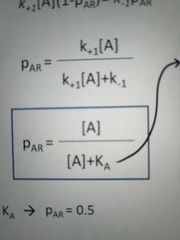
An equation relating bound receptor occupancy, drug concentration, and Ka |
|
|
What is Ka? |
The equilibrium dissociation constant, the concentration of a drug that is required for bound receptor occupancy to be 50% |
|
|
What can Ka be used to measure? |
Affinity - the higher the affinity, the lower the Ka |
|
|
What is another way of denoting Ntot? |
Bmax, the maximum binding potential |
|
|
What is another way of denoting Nar? |
B, the number of bound receptors |
|
|
What is the name for the plot of B/[A] against B? What is its equation? |
The Scatchard plot B/[A] = Bmax/Ka - B/Ka |
|
|
How do we quantify drug binding in a lab? |

Label the drug with a radioactive trace and allow it to bind to the receptor. Wash away the supernatant and measure radioactivity. Some will be non-specific binding, so to account for this, repeat by first allowing non-radioactive drug, then radioactive drug, to bind to receptor. This time, only non-specific binding will take place. Wash away supernatant and measure again. Take second radioactivity away from first |
|
|
What is a dose response curve? |
A curve which plots the concentration of a drug to the size of the response |
|
|
What is EC50? |
The concentration of a drug required to produce half-maximal response |
|
|
Why is Ka not the same as EC50 |
Ka is concn required to produce 50% occupancy, EC50 is concn required to produce 50% response. There may be spare receptors present so you don't need half the receptors to produce half the response |
|
|
Which is typically lower, EC50 or Ka? |
Ec50 |
|
|
What are the two types of Agonist? |
Full and partial - partial agonists will never produce the maximal response |
|
|
How would you represent agonists with different affinities on a dose response curve? |
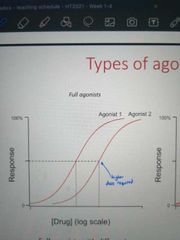
|
|
|
How would you represent agonists with different efficacies on a dose response curve? |

|
|
|
Give an example of a full Agonist |
Salbutamol, a B2 Agonist used to treat asthma |
|
|
Give an example of a partial agonist |
Buprenorphine, an opioid receptor used to treat opoid dependence |
|
|
What are the 3 types of antagonist? |
Competitive reversible Competitive irreversible Non competitive |
|
|
How do competitive Antagonists work? |
By binding to the same site as the drug and preventing the Agonist from doing so |
|
|
What do competitive Antagonists do in terms of EC50? |
They increase it, meaning you need more drug to produce 50% response. The ratio between the normal EC50 and the new EC50 is called the dose ratio |
|
|
What is the equation for the dose ratio? |
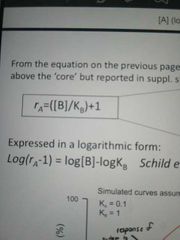
|
|
|
What is the effect of an irreversible antagonist on max response? |
It decreases it because it lowers the availability of receptors |
|
|
How do irreversible Antagonists work? |
By forming covalent bonds to the receptor site, staying there indefinitely |
|
|
What effect does non-competitive antagonist have on EC50 and max response? |
Increases EC50 and decreases max response |
|
|
Give an example of a competitive antagonist? |
Carvedilol - B1 antagonist, used to treat hypertension |
|
|
Give an example of a non-competitive antagonist? |
Ketamine |
|
|
What is constitutive receptor activity? |
When a receptor produces a biological response even without a bound ligand, and the ligands job is only to modulate the innate response |
|
|
How do inverse agonists work? |
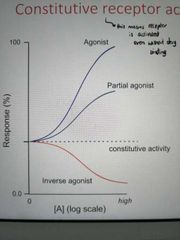
They bind and induce a response, but that response is to decrease the signal that was innately being produced without any receptor activation |
|
|
Derive the Hill-Langmuir equation |
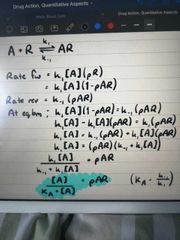
|

